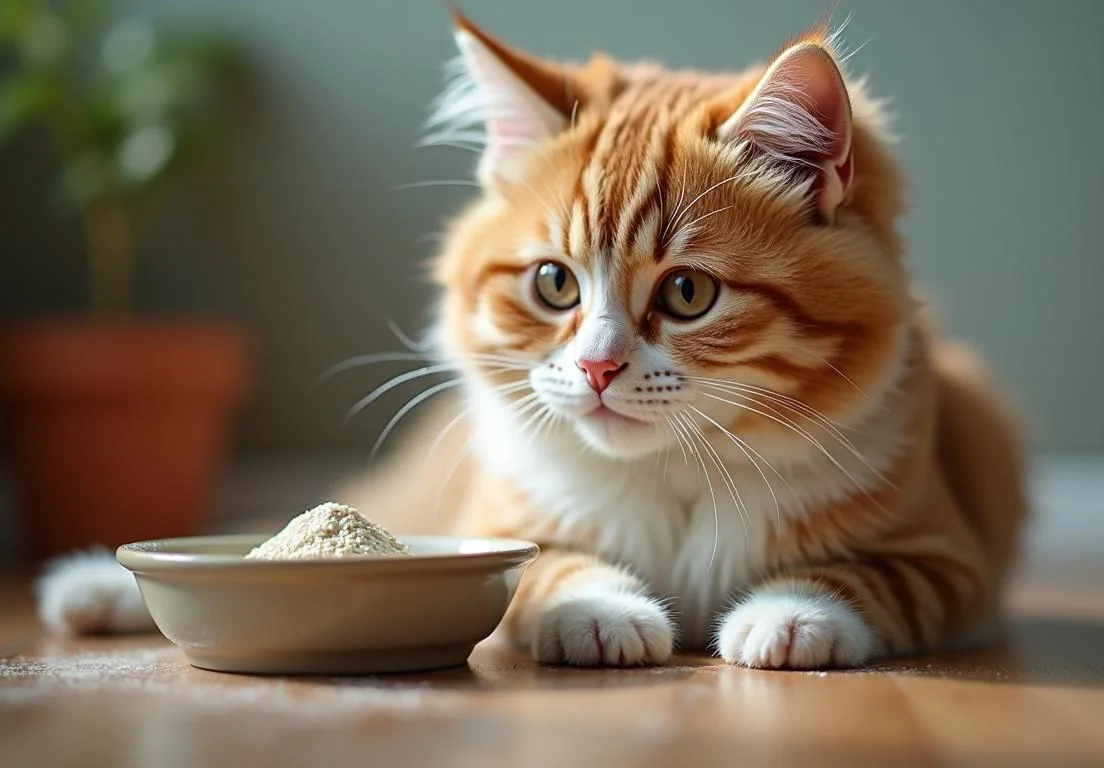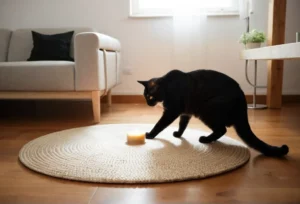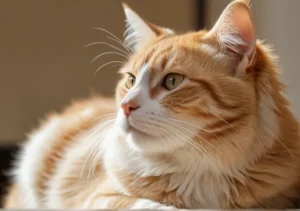Cats are fascinating creatures with some peculiar habits that intrigue their human companions. One such habit? The ritual of cleaning themselves after mealtime. It’s almost as if they’re savoring the experience even more after they’ve dined.
Cats clean themselves after eating primarily for hygiene and comfort. By grooming, they remove food particles and any scent that might attract predators, while also redistributing their natural oils for a sleek coat. There’s more to this behavior than just a simple act of cleanliness, and what follows will uncover the intriguing reasons behind this common feline ritual.

Instinctual Behavior of Cats
Cats are often seen grooming themselves right after a meal, and that’s no coincidence. This behavior is deeply rooted in their instinctual habits that date back to their wild ancestors. In the wild, maintaining cleanliness is crucial for survival. When hunting, wild cats might roll in the dirt or get covered in debris; once they’ve satisfied their hunger, cleaning helps conceal their scent from potential predators or prey.
Grooming isn’t just a cleanliness ritual; it’s also a soothing mechanism. After a good meal, those little tongue-scrapes help them relax. The repeated motions and the friction against their fur can actually be quite comforting, allowing them to settle down after the excitement of eating. Cats are naturally wired to care for themselves, and each grooming session reaffirms that connection to their primal instincts.
The Role of Hygiene
Grooming is more than just fluffing up their fur; it plays an important role in a cat’s overall hygiene and health. When cats lick themselves, they distribute natural oils throughout their fur, which keeps their coats shiny and healthy. Additionally, saliva contains enzymes that can have antibacterial properties, meaning grooming helps reduce the risk of skin infections.
Moreover, proper hygiene is crucial in maintaining a cat’s temperature regulation. By keeping their fur clean and tidy, they can better manage their body heat.
Consider these points about feline hygiene:
– Preventing Furballs: Regular grooming helps minimize ingested hair, reducing the frequency of hairballs.
– Skin Health: Grooming stimulates blood flow to the skin, promoting healthier skin and better fur growth.
– Bonding Opportunity: Grooming can also serve as a bonding moment between pet and owner, as some cats enjoy a gentle brush or comb.
By understanding the reasons behind this behavior, you can appreciate just how significant grooming is in a cat’s daily routine. It’s a blend of instinct, hygiene, and comfort that keeps your feline friend both happy and healthy.
Psychological Benefits
Grooming serves as a self-soothing mechanism for cats. After a satisfying meal, they often feel the need to unwind, and licking themselves helps achieve that sense of relaxation. This act can reduce anxiety and create comfort in their environment. The repetitive action of grooming releases endorphins, promoting a sense of well-being. It’s akin to enjoying a cozy blanket after a hearty meal—cats find comfort in their routine, which includes cleaning themselves. Plus, this post-meal grooming ritual can enhance their bonding behavior with other cats; they often mimic this activity in social settings, reinforcing closeness and security within their space.
Why Scent Matters
Scent plays a crucial role in a cat’s world. After eating, they instinctively groom to hide the odors that remain from their meal. This is particularly important, as strong food scents can attract predators or unwanted attention from competitors. With their superior sense of smell, cats are wired to mask their scent to maintain stealth.
Some convincing reasons why this is essential include:
– Predator Awareness: Helps avoid detection by potential threats in their environment.
– Pack Hierarchy: In feral settings, masking the scent of food reinforces their position within their group, reducing rivalry.
– Hygienic Reasons: Keeps their fur cleaner, preventing bacteria build-up that could occur from food particles.
Mimicking behaviors from their wild ancestors, this instinctual action remains relevant even in our domesticated companions, underlying an instinctive survival strategy.
The Grooming Routine Explained
After a satisfying meal, a cat’s grooming ritual is not just about cleanliness; it’s an instinctive behavior deeply rooted in their nature. Cats will often start by licking their paws before wiping their face, typically starting with a thorough cleaning around the mouth and whiskers. This is vital because their sensitive whiskers can trap food particles that they want to get rid of.
Next, they move onto their fur, often licking each area with care. Cats have specialized tongues covered in tiny, hook-like structures called papillae, which help remove remnants of food and stimulate the skin. Not only does this grooming help maintain their coat, but it also serves a thermoregulatory function, keeping their body temperature stable by spreading natural oils.
Beyond hygiene, this behavior is also about comfort and security. Cats often feel more at ease after eating when they groom themselves, as it can reduce stress. For many felines, grooming can be a soothing ritual that helps them transition from the excitement of mealtime to a state of relaxation.
How Age Affects Grooming Habits
Just like humans, a cat’s grooming habits evolve as they age. Kittens are usually meticulous but may need a little help at first to ensure they’re cleaning thoroughly after eating. They often learn by watching their mothers.
As they move into adulthood, cats typically hit their grooming stride, managing to clean themselves efficiently. However, as they transition into senior years, you may notice a decline in their grooming routine. Older cats may struggle with mobility, making it harder to reach certain areas, leaving them less able to keep clean.
For senior cats, it’s often beneficial to keep an eye on their grooming habits. If they seem to avoid cleaning themselves after meals or start developing mats in their fur, it might be time for some gentle assistance or a check-up with your vet. Sometimes, they simply need a little extra help to maintain their coat as they age gracefully.
Fun Facts About Cat Grooming
Cats have a reputation for being meticulous groomers, and there’s more behind this behavior than just vanity. Did you know that grooming plays a crucial role in a cat’s overall health? It helps distribute natural oils in their fur, keeping it shiny and hydrated. Interestingly, when cats groom after eating, they’re not just tidying up; they’re also regulating their body temperature through the evaporation of saliva on their fur.
Additionally, the act of grooming is often instinctual and connected to their wild ancestry, where extra cleanliness could mean the difference between life and death. Cats also use grooming as a way to alleviate stress; so, if you see your cat cleaning themselves after a meal, it might be their way of unwinding. Lastly, some studies suggest that cats can even detect their owner’s scent through their grooming behaviors, reinforcing their bond with us.
Related Rituals in the Animal Kingdom
Grooming after meals isn’t exclusive to cats; it can be seen across various species, each with unique motivations. For example, dogs often engage in grooming after eating to remove food residue, similar to cats. However, dogs may be more likely to use their paws or even rub against surfaces, whereas cats prefer the precision of their tongue for a more thorough clean.
Birds like parrots and swans also partake in post-meal grooming activities. Parrots use their beaks to arrange their feathers, maintaining their appearance and ensuring their feathers are properly oiled. Swans, on the other hand, clean their feathers to aid buoyancy and waterproofing, which is essential for their survival.
Among larger mammals, primates often groom each other after meals, a social behavior that strengthens bonds within their group. This act is more than just physical cleanliness—it’s a way to build relationships and establish hierarchies. The parallels in grooming behavior across species highlight its significance beyond mere hygiene, reinforcing social connections and individual health throughout the animal kingdom.
Alex, a passionate animal lover, has experience in training and understanding animal behavior. As a proud pet parent to two dogs and three cats, he founded AnimalReport.net to share insights from animal experts and expand his knowledge of the animal kingdom.




